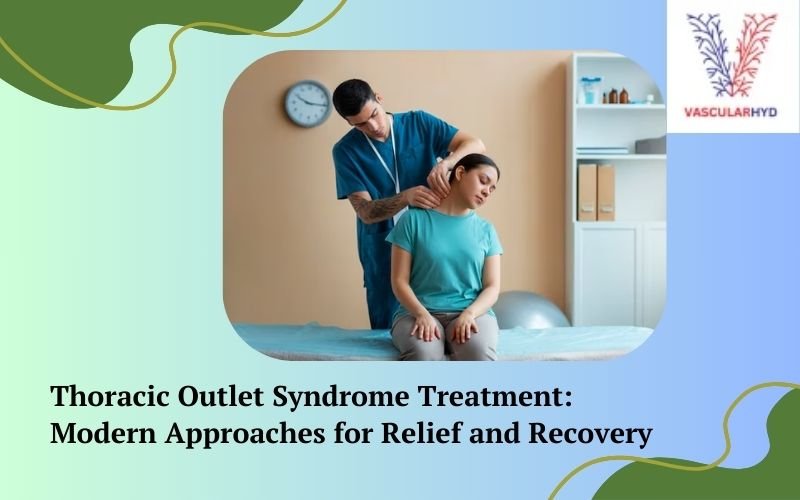Thoracic Outlet Syndrome (TOS) is a condition that can significantly impact a person’s quality of life, causing pain, numbness, and weakness in the arms and hands. For those affected, finding effective thoracic outlet syndrome treatment is crucial to regain mobility and comfort. Dr. Rahul Agarwal, specialize in diagnosing and treating TOS using modern, evidence-based approaches. In this blog, we’ll explore the types, symptoms, prevention strategies, and the latest treatment options for thoracic outlet syndrome.
What is Thoracic Outlet Syndrome?
Thoracic Outlet Syndrome occurs when nerves or blood vessels in the thoracic outlet—the space between your collarbone and first rib—become compressed. This compression can lead to a range of symptoms, from mild discomfort to severe pain and functional limitations. Understanding the condition is the first step toward effective thoracic outlet syndrome treatment.
Types of Thoracic Outlet Syndrome
There are three main types of TOS, each with distinct causes and symptoms:
- Neurogenic TOS (Most Common):
- Caused by compression of the brachial plexus nerves.
- Symptoms include pain, numbness, tingling, and weakness in the arms and hands.
- Venous TOS:
- Caused by compression of the subclavian vein.
- Symptoms include swelling, discoloration, and a feeling of heaviness in the arm.
- Arterial TOS (Rarest):
- Caused by compression of the subclavian artery.
- Symptoms include coldness, pale skin, and a weak pulse in the affected arm.
Recognizing the type of TOS is essential for tailoring the right thoracic outlet syndrome treatment plan.
Symptoms of Thoracic Outlet Syndrome
The symptoms of thoracic outlet syndrome vary depending on the type and severity of the condition. Common symptoms include:
- Pain in the neck, shoulder, or arm.
- Numbness or tingling in the fingers.
- Weakness in the hands or arms.
- Swelling or discoloration in the arm (more common in venous TOS).
- Coldness or pale skin in the affected area (more common in arterial TOS).
If you experience any of these symptoms, it’s important to seek professional evaluation to determine the best course of action.
Causes and Risk Factors
Thoracic Outlet Syndrome can result from various factors, including:
- Trauma or injury to the neck or shoulder.
- Repetitive overhead movements (common in athletes or certain occupations).
- Poor posture, especially with prolonged sitting or computer use.
- Anatomical abnormalities, such as an extra rib or tight muscles.
Understanding these causes can help in both prevention and treatment.
How to Prevent Thoracic Outlet Syndrome
Preventing TOS involves addressing risk factors and adopting healthy habits. Here are some practical tips:
- Maintain Proper Posture:
- Sit and stand with your shoulders back and head aligned with your spine.
- Avoid slouching, especially during long periods of sitting.
- Ergonomic Adjustments:
- Set up your workspace to minimize strain on your neck and shoulders.
- Use ergonomic chairs, keyboards, and monitors.
- Regular Exercise:
- Strengthen your shoulder and neck muscles with targeted exercises.
- Incorporate stretching routines to improve flexibility and reduce tension.
- Avoid Repetitive Strain:
- Take frequent breaks during repetitive activities.
- Alternate tasks to reduce prolonged strain on specific muscles.
By following these steps, you can lower your risk of developing thoracic outlet syndrome.
Diagnosis of Thoracic Outlet Syndrome
Accurate diagnosis is the foundation of effective thoracic outlet syndrome treatment. Dr. Rahul Agarwal use a combination of:
- Physical examinations to assess symptoms and range of motion.
- Imaging tests (X-rays, MRI, or CT scans) to identify structural abnormalities.
- Nerve conduction studies to evaluate nerve function.
Early diagnosis ensures timely intervention and better outcomes.
Modern Approaches to Thoracic Outlet Syndrome Treatment
Dr. Rahul Agarwal, we offer a range of modern treatment options tailored to each patient’s needs:
- Non-Surgical Treatments:
- Physical Therapy: Customized exercises to improve posture, strengthen muscles, and relieve compression.
- Pain Management: Medications or nerve blocks to reduce pain and inflammation.
- Lifestyle Modifications: Ergonomic adjustments and activity modifications to prevent symptom recurrence.
- Surgical Treatments:
- Rib Resection: Removal of the first rib to relieve compression.
- Scalenectomy: Removal of part of the scalene muscle to reduce pressure on nerves and blood vessels.
- Surgery is typically recommended for severe cases or when non-surgical treatments fail.
- Emerging Therapies:
- Botox Injections: To relax tight muscles and reduce nerve compression.
- Regenerative Medicine: Innovative approaches like platelet-rich plasma (PRP) therapy to promote healing.
Our goal is to provide relief and restore function through the most effective thoracic outlet syndrome treatment options available.
Recovery and Rehabilitation
Recovery from TOS depends on the severity of the condition and the treatment approach. Here are some tips for a smooth recovery:
- Follow your physical therapy program diligently.
- Practice good posture and ergonomic habits.
- Attend follow-up appointments to monitor progress.
With proper care, most patients experience significant improvement in their symptoms.
Why Choose Dr. Rahul Agarwal for Thoracic Outlet Syndrome Treatment?
Dr. Rahul Agarwal combine expertise, advanced technology, and a patient-centered approach to deliver the best possible care. Our team is dedicated to helping you achieve relief and recovery through personalized thoracic outlet syndrome treatment plans.
Conclusion
Thoracic Outlet Syndrome can be challenging, but with the right diagnosis and treatment, relief is possible. If you’re experiencing symptoms of thoracic outlet syndrome, don’t wait—seek professional help today. Dr. Rahul Agarwal is here to guide you every step of the way. Contact us to learn more about our modern approaches to thoracic outlet syndrome treatment.
FAQs
- What are the long-term effects of untreated TOS?
- Untreated TOS can lead to chronic pain, muscle weakness, and permanent nerve damage.
- Can TOS be cured without surgery?
- Yes, many cases of TOS can be managed effectively with non-surgical treatments like physical therapy and lifestyle changes.
- How long does recovery take after TOS treatment?
- Recovery time varies, but most patients see improvement within a few weeks to months with proper treatment.
- What exercises help relieve TOS symptoms?
- Stretching and strengthening exercises for the neck, shoulders, and upper back can help alleviate symptoms.






.png)

 (1).png)
